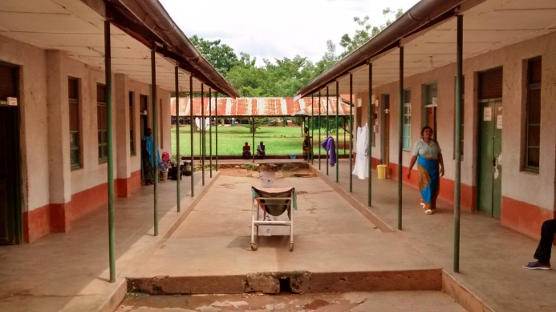Healthcare for Mothers and Children in Tanzania and South Africa: What Do External Actors Provide?
News from Aug 24, 2016
How strong do state structures have to be for international actors to provide effective governance? This question is the focus of my research in project B2, “The Governance Contribution of External Actors in Areas of Limited Statehood,” with a concentration on maternal and children’s health in Tanzania and South Africa. The health sector in Sub-Saharan Africa attracts billions of US dollars in development aid. At the same time, an array of international and non-governmental organizations and bilateral donors are active in the field as well. Both in practice and in current scholarship, the strength of state structures has gained prominence as a condition for the success of development cooperation and governance provision. My research takes Tanzania as a case study for a relatively weak state and South Africa as a case study for a relatively strong one. At the beginning of the year, I visited each country for four weeks in order to collect documents and conduct expert interviews with external actors and employees of state ministries.
In Tanzania, the field of relevant actors is very complex; many well-known organizations and donors claim on their websites and in conversation that they are working to fight maternal and infant mortality. A targeted follow-up, however, often reveals that the number of concrete projects is much lower than suggested, and these are usually carried out cooperatively by a number of different actors. So when four different organizations told me about their projects, but in fact they were all referring to exactly the same project, the potential positive effect on local healthcare provision was much less than I had initially assumed. Indeed, many interview partners confirmed that the actors involved are poorly coordinated. Due to inadequate personnel resources and overly complex bureaucratic processes, the Ministry of Health is only somewhat capable of taking on its coordinating position. Nevertheless, smaller projects did seem to be effective, as evaluation reports by the various actors made clear. These projects are discussed with the Ministry of Health in their conception phase but implemented with broad autonomy by the organizations and donors after that; they therefore only partly rely on strong state structures.
Beyond my interviews, I was also able to gain a direct impression of rural healthcare in Tanzania. I accompanied a GIZ team to Masasi in the Mtwara region on the country’s southern border in order to observe a two-day, on-the-job training session in the maternity and neonatal ward of the district hospital. This type of training program is a common, project-related measure and is carried out by a variety of actors in Tanzania. By refreshing and expanding on doctors’ and nurses’ knowledge, the training aims to make a sustainable contribution to reducing maternal and infant mortality. That the hospital has a neonatal unit at all is an anomaly in rural Tanzania. But at first glance, everything seems to be deficient: the mosquito nets over the beds are not intact and provide no protection against malaria; none of the faucets work, so instruments are sterilized in rain water in plastic buckets; blackouts occur several times a day; the rooms reach more than 40ºC (104ºF), and the foreheads of mothers and newborns are covered in beads of sweat. Despite all this, lives are saved here every single day. Whether or not the training program is effective in the long term can only be determined in one or two years when the GIZ team returns. When a different organization conducted a similar session here a while ago, they brought along material to collect patient data – forms that, during my visit, were lying unused in the corner. Apparently the donor organization’s initiative had gone nowhere.
The situation in South Africa’s health sector is entirely different. Here, most external funding is tied to fighting HIV/AIDS, while other areas of healthcare are simply ignored. This trend is increasingly revealing itself as a problem for areas such as maternal health, where the provision of care is riddled with basic insufficiencies. Compared to Tanzania, far fewer actors are involved in maternal and children’s health. Those that are active, however, are in much closer contact with the Ministry of health and are well coordinated. Instead of multiple smaller training programs like in Tanzania, South Africa hosts one large initiative funded by Great Britain and the EU, coordinated by the Ministry of Health and implemented by the University of Pretoria. Training sessions have taken place in many hospitals around the country, and the results are striking. Still, the actors involved complain of partisan conflicts, which play out – via bureaucracy – even in technical political fields such as health and significantly slow down the implementation process.
During my stay, clear differences emerged between the two countries with respect to the role of international organizations and bilateral donors in healthcare provision, as well as the role and capacity of state structures. In Tanzania, external actors play a much more central role than in South Africa, but because state structures lack bureaucratic capacity, these actors are not coordinated as well. At the same time, a high degree of statehood does not seem to be a prerequisite for the effective implementation of individual (smaller) projects. This leads to the hypothesis that the degree of statehood is relevant not necessarily to the effectiveness of specific projects but rather to the impact of external actors on healthcare provision as a whole. In this sense, my trip made an important contribution to the B2 project’s research agenda.
 |
About the author: Luisa Linke-Behrens is a Research Associate in project B2, “The Governance Contribution of External Actors in Areas of Limited Statehood,” and investigates statehood as a condition for effective governance provision by external actors in Tanzania and South Africa. |

